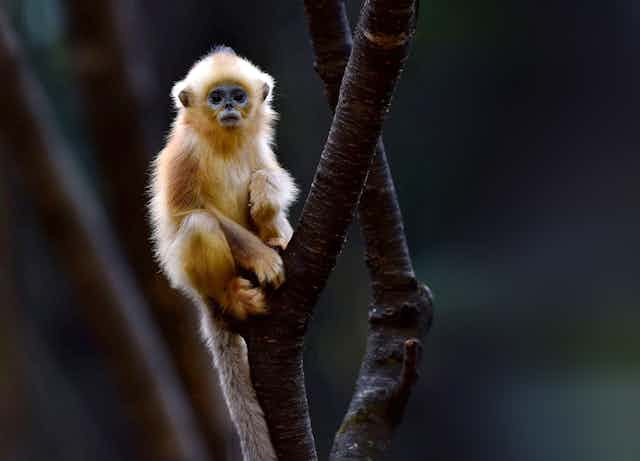Most primates — monkeys, apes, lemurs, lorises and tarsiers — live in a tropical belt that stretches around the equator from Central and South America to Africa and Asia. But the majority of them are found in four different countries — Brazil, Madagascar, Indonesia and the Democratic Republic of the Congo — so many people have not had direct contact with them.
Still, we may know them from films, like the capuchin in Pirates of the Caribbean, or may have heard of their stealthy abilities, like the macaques who pickpocket travellers. Some are important cultural or religious symbols, like macaques.
These animals also play key roles in their ecosystems, pollinating flowers and dispersing seeds. Although there are around 500 primate species in the world, three-quarters of them are facing population declines.
Because most primates live near the equator, many are especially vulnerable to climate change. In a recent study, my colleagues and I looked at what would happen to primate species around the world if global temperatures rose 2 C, the upper limit set by the Paris Agreement. The results showed that a quarter of all primate habitat will experience prolonged heat extremes. They give conservation scientists important information on how climate change will influence primate populations in the future.
New heat extremes
We already know that global warming will not be uniform across the planet. The Arctic is warming faster than places closer to the equator, for example. But for animals already living in hot places, a slight increase in temperature could readily move them past a threshold and outside their comfort zone.
The threshold temperatures in our study represent the hottest temperature that each primate species would have faced in pre-industrial times. We then compared future average temperatures to this baseline.
Under the Paris Agreement, nations pledged to keep global warming to 2 C above pre-industrial levels. Yet we found that under that scenario, 26.1 per cent of all the habitats where primate species live will be hotter than their threshold temperatures. For some species, such as the patas monkey and the Senegal bushbaby in Africa, this could mean long periods throughout the year where temperatures surpass 33 C.

Like humans, primates overheat and become dehydrated with continued physical activity in extremely hot weather. In a warmer future, they would have to adjust, resting and staying in the shade during the hottest times of the day. This could mean foraging less or not mating, which could limit overall food intake and change reproductive cycles.
Those species living in the Brazilian Amazon, along the north coast of Venezuela, the centre of equatorial Africa, the African east coast and the northwest coast of Madagascar will be most affected. Those that are already endangered, have populations occupying less than 12,000 square kilometres and are facing significant temperature increases — such as annual averages consistently above 27 C — are at greatest risk of extinction with the compounding effects of climate change.
For instance, the Celebes crested macaque (the famous “monkey selfie” primate) and the Siau Island tarsier are both critically endangered in small habitats, while currently experiencing year-round temperatures above their historic thresholds.
Our analysis also showed that climate change has already pushed eight per cent of primate species habits past their thresholds. This means some populations may be facing additional stress due to hotter temperatures and changing their behaviour to compensate. These species all have declining populations and have been categorized as close to extinction — the new heat extremes could be partially to blame.
Human impact
It’s easy to assume that warmer global temperatures would lead to an increase in the habitat primates favour, by stretching it north and south and upwards on mountain slopes. But because of human population growth, infrastructure and agriculture, some species may not be able to move to these newly suitable areas.
Many primates prefer to avoid us and our roads, cities and fields block them from getting there. In some cases, there is no habitat for them to move to, because it has been logged, mined or degraded in some other way.

About 60 per cent of non-human primate species are currently threatened with extinction, and climate change is only a part of it. Habitat loss, hunting, the illegal pet trade and disease have already cut back primate populations. Climate change will likely increase the duration and intensity of extreme weather events such as cyclones and droughts, putting more pressure on the survival of already struggling species.
Conservation is key
Our model did not include conservation issues, such as habitat loss, that primates are already facing. Yet the areas with the most primate species predicted to surpass temperature thresholds have also been identified as suitable for the expansion of palm oil plantations. The combination of the two would only further reduce these species’ access to suitable habitat and put them at greater risk of extinction.
Nature reserves have been helpful in maintaining populations of wild animals. However, the borders of wildlife reserves and protected areas are usually fixed and not easy to move. Future temperature increases could alter the habitat within a protected area so that it is no longer suitable for the primate species living there now.
Considering the rapid rate of climate change, future primate conservation should include predicted temperature changes in combination with the other issues that primates face. For example, wildlife reserve boundaries could be chosen based on future climatically suitable habitat for a species. Primates are amazing and fascinating animals that deserve a home on this planet alongside us.

